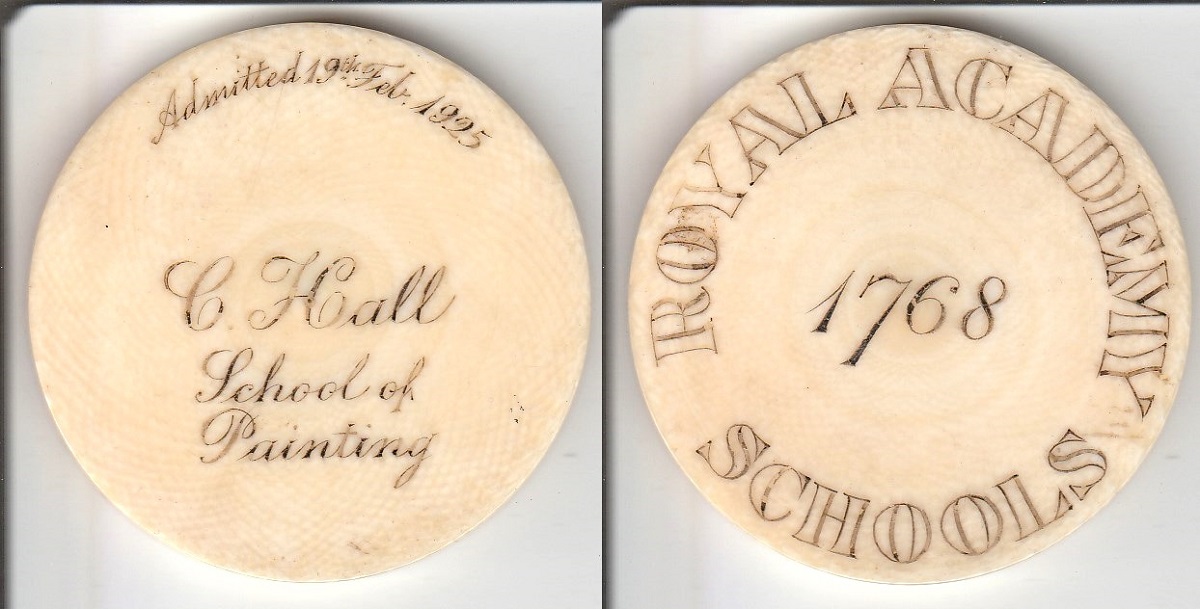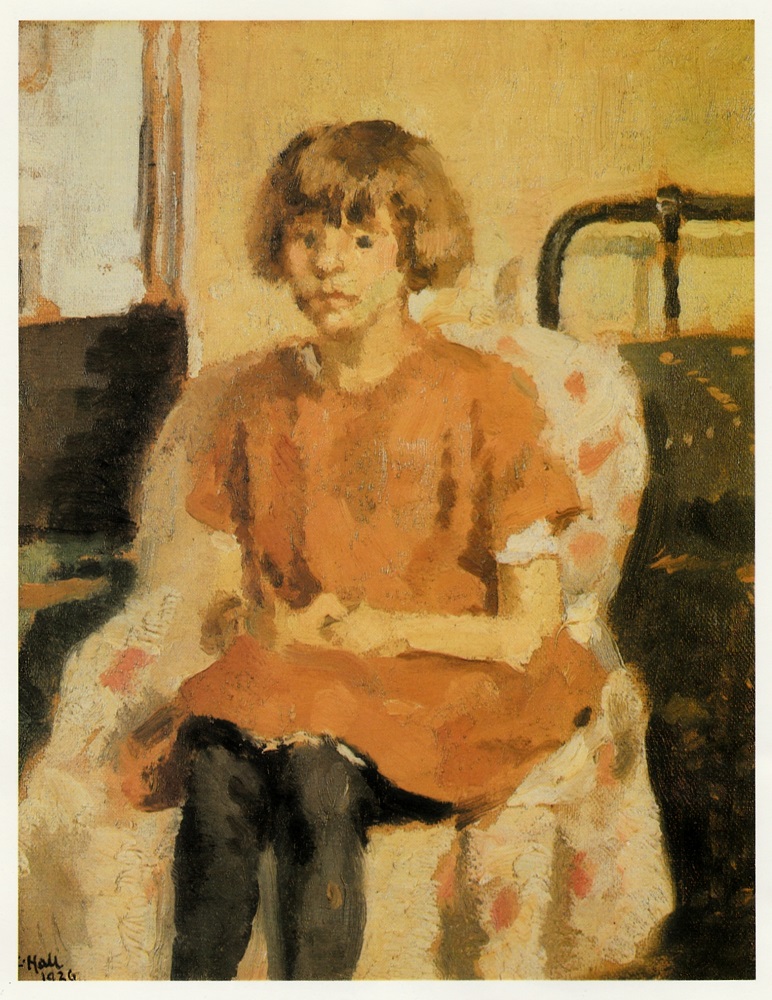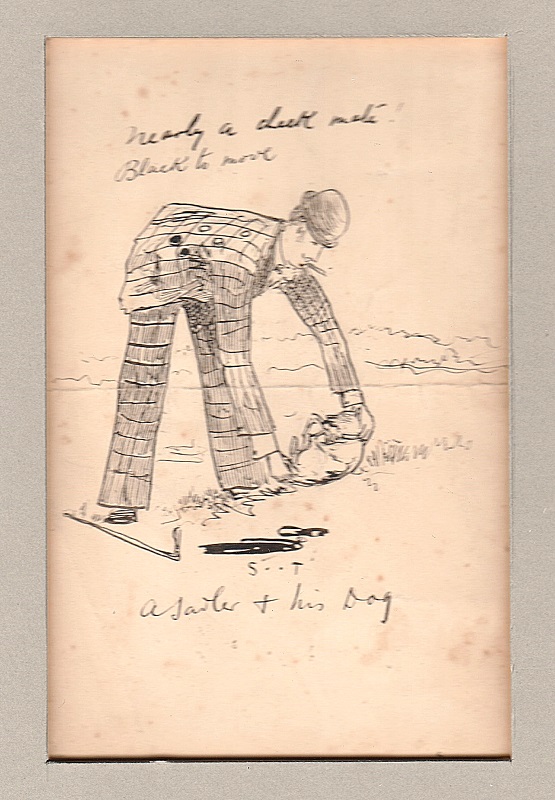


When Woolliscroft Rhead died a big memorial exhibition was arranged by his son in the Great Hall. There were paintings in oil and watercolour, drawings and etchings. The Rossetti-like women in these pictures greatly appealed to my romantic desires. I had already decided I wanted to be an artist and this wish had not made my parents happy and understandably so, for there was no widespread system of grants for students then, and they were not well off. Finally, and largely due to my mother's influence, it was agreed to let me go to an art school but only on condition I did Design. There was more money in it they said. It was the thin edge of the wedge and I agreed. After some evenings drawing the Antique at Richmond Art School - Charles Wheeler taught there - I went full time to Putney School of Art and for a year I studied Design. Gradually and deliberately I got away from my Design classes and into Life Drawing and Painting and after some years I was able to gain entrance to the Royal Academy Schools.
I have said I hated my schooldays. I did, but I loved my time as an art student. Compared with most of the students I have to teach I was a hard worker, but I had plenty of fun too. Almost without exception I thought highly of my masters and was grateful for what they had to teach me. They were, unlike most present-day teachers, concerned with teaching the craft. They wanted us to learn the job thoroughly. Temperament was not popular with them and ideas were of little use without the knowledge with which to express them. Now, every student in his teens wants to run before he can walk and they are encouraged to try, even told they have succeeded, when in reality they have scarcely begun.
Perhaps it was a method which made me over cautious, for a while, but I am grateful for it and I think it suited me at the time. At Putney, what an eye Toddy Swain had for values and how he kept us at getting them right even if his training was academic and weak academic at that. The Principal, John Bowyer*, was a sensitive artist with immense knowledge, George Morrow a great draughtsman - I still have some of the sketches he did for me - and Stanley Anderson before he became an RA and gave up serious work was a teacher with immense vitality, full of ideas and he drew brilliantly.
*James (John) Bowyer (1872-1941).
I did some modelling there under Charles Doman, an amazing technician who helped me and sometimes made me wish to be a sculptor and not a painter.
Charles Sims, who I was really afraid of when I first went to the RA Schools, I came to admire very much.
I had made an unfortunate start with a thoroughly bad painting and Sims had first looked at my painting, then at me, again at my painting and again at me without saying a word. Then he said, and I will never forget it: 'You will agree that when one is called upon to criticize there should be something to criticize.' I mumbled 'Yes.' He then said he could see absolutely nothing there and he left me alone for months. Quite a long time after, I was painting a half- length nude of a model called Marie Noble. Sims, on his way round the class, stopped and looked at it and praised it highly. That same evening, I saw him in the corridor and he said he hoped I had not spoiled the painting. I told him I had done nothing more to it but had begun another. He looked at me through the big horn-rimmed glasses he always wore, 'It was very good, very good, although,' he added, 'it could have been better, but do you know, I have been painting that girl and you got something I couldn't get.' He turned and walked quickly away.
Some years after, when I had a studio in Jubilee Place, I met Marie in the Commercial and invited her back for a drink. She began to talk of when she sat at the Schools and how she had sat for Sims too. 'One day he threw himself at my feet and said he loved me. Wasn't he a funny man!'
Before Sickert's visit to the Royal Academy Schools, sometime in 1926 or 7, Charles Sims called the students together. He told us Sickert would be the next visitor, that he was not only one of the greatest painters we had but also one of the greatest teachers. He proposed to give him an absolutely free hand and we were to co-operate in every way.
Sickert arrived the following morning at 10 o'clock. He asked a few pointed questions about methods of work, posing of models and so on and then he proceeded to reorganize everything. It was done quickly and efficiently and his way worked smoothly from the very first day.
He had great authority and great charm. The three models, who normally would have posed singly in three separate studios, were posed together in a group. This group was placed in the centre of the studio. We had been used to having the model placed against a drapery background; now we were told we must relate this group of three to whatever happened to come near and behind them; other students or a corner of the studio, maybe.
The insistence was on drawing, and still more drawing. Drawings were to be considered as 'documents'. They must contain as much information as possible.
Colour sketches, in oil colour, were to be made, painted in one sitting, on canvas or board 'primed the colour of a cigar box'. These colour sketches to be as coloured as was consistent with fine tonal values, and they were for use in conjunction with our drawings when we were ready to paint the finished picture - away from nature.
Because one of the girls in the group found her pose too difficult, a man was engaged in her place. He was made to wear a woman's dress and Sickert bought a wig of long black hair for him.
This model I remember was Mario Mancini, a brother of Alf Mancini the boxer.
'I am not,' said Sickert, 'going to stumble in and out between easels whilst you are working.' He told us how he wanted us to work and at the end of the week, the models not being present, he expected us to show him all we had done. Each student then received an individual criticism. He was told what applied to his particular needs, yet the criticism was full of advice that was needed by all of us and one gained immensely from listening to all the criticisms; indeed, Sickert expected us to do so.
We were also told to write down what he told us and post our notes to him.
This method, the master posing the models, giving the students a talk on the various possibilities of the motif, leaving them to get on with it and at the end of the week's work giving each a searching and constructive criticism of their efforts is, of course, not the English method of teaching; at least as I have found it in our Art Schools.
Later, when I studied under André Lhote in Paris, his procedure was the same as Sickert's.
In our Art Schools the students used to be given far too much attention all the time, and tended to rely on the masters whenever any difficulty arose. In recent years, however, the climate has changed and the majority seem to prefer to be left alone 'to express themselves'.
Commencing a drawing. We could begin with whichever portion interested us most. We must proceed to relate the shapes immediately next to the one we had started with and so on, constantly relating shape to shape, 'with no jumps', until the drawing 'bumped up against the four edges of the paper'.
This, he said, had been told him by Whistler, who described it as the secret of drawing. Sickert remembered writing it all down on his cuff.
The drawing must be commenced with a faint 'tentative line'. Next, the values were put in, starting with the darkest, 'to give the map solidity', and finally, a firmer, more searching 'line of definition' was added.
These were the three main stages, although naturally they could and did overlap according to the ability of the student.
Pencil or black chalk, not too soft and with a good point had to be used and India rubber was not allowed.
Corrections, that is to say several outlines in search of the true one, could be made and when the corrections became confusing, as they often did in the pencil stage, further corrections were put in with ink.
A number of drawings from the same viewpoint was advised for each could contain some extra scrap of information and might play its part in the final building up of the picture.
When it came to deciding the design of the picture, Sickert advised which drawing would work out best. Design was not a word he used, but like Degas, he was a master of the cut. 'Add a piece here, take off some there', and the result was usually a piece of good placing, even of good design, in spite of this somewhat chancy procedure.
EARLY LIFE MEMOIR -3
Clifford Hall's Royal Academy School Admission Token shows that he entered the school on 19th February 1925. Sources which state that he attended 1926-27 are therefore clearly incorrect.
Clifford Hall had no known ancestors who were artists. Most of the Hall men seem to have worked in agriculture, husbandry and the clergy or the military. His nearest known artistic relative was Leonard Patten. Clifford owned this little drawing by Patten and left a note attached to the back of it which states:
'Patten was my father's second cousin and once shared lodgings with him This sketch is a souvenir of a country walk. My father, Patten, Sadler and his dog. Sadler wore a loud check suit. The dog rolled in a cow pat.
Patten worked for a number of magazines including the illustrated London News, also the Daily Telegraph. He came from Bournemouth, and as a young man made a large drawing of that town as seen from a boat offshore.'
'Seated Girl in an Orange Dress' by Clifford Hall. Signed and dated 1926. Oil on canvas, 12x10 inches. An early example of the artist's work done while he was still attending the RA Schools. The identity of the sitter is not know.


